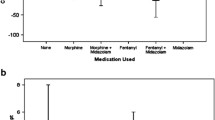Abstract
OBJECTIVE:
This study tested the hypothesis that highly fretful, narcotic-withdrawing neonates experience less distress in a prone-lying position than comparable, supine-lying neonates.
STUDY DESIGN:
Equivalent numbers of randomly assigned, narcotic-withdrawing newborns were assigned to prone-lying (n = 25) or supine-lying (n = 23) conditions. Subjects in the two groups were similar with regard to gestational age, birth weight, and clinical presentation. Peak and mean withdrawal severity, as measured by Neonatal Abstinence Scoring System (NASS) scores and daily caloric intake, were compared between supine and prone groups by Wilcoxon’s two-sample test.
RESULTS:
The prone-lying neonates had lower peak NASS scores (p < 0.0001), lower mean NASS scores (p < 0.0001), and lower caloric intake (p < 0.001) than supine-lying, narcotic-withdrawing newborns.
CONCLUSION: The fretfulness associated with neonatal withdrawal and other stressful conditions can be moderated by laying the affected infant prone. The pronate quieting response is a significant, endogenous source of neonatal pacification.
Similar content being viewed by others
Author information
Authors and Affiliations
Rights and permissions
About this article
Cite this article
Maichuk, G., Zahorodny, W. & Marshall, R. Use of Positioning to Reduce the Severity of Neonatal Narcotic Withdrawal Syndrome. J Perinatol 19, 510–513 (1999). https://doi.org/10.1038/sj.jp.7200260
Published:
Issue Date:
DOI: https://doi.org/10.1038/sj.jp.7200260
- Springer Nature America, Inc.
This article is cited by
-
Review of the assessment and management of neonatal abstinence syndrome
Addiction Science & Clinical Practice (2014)




